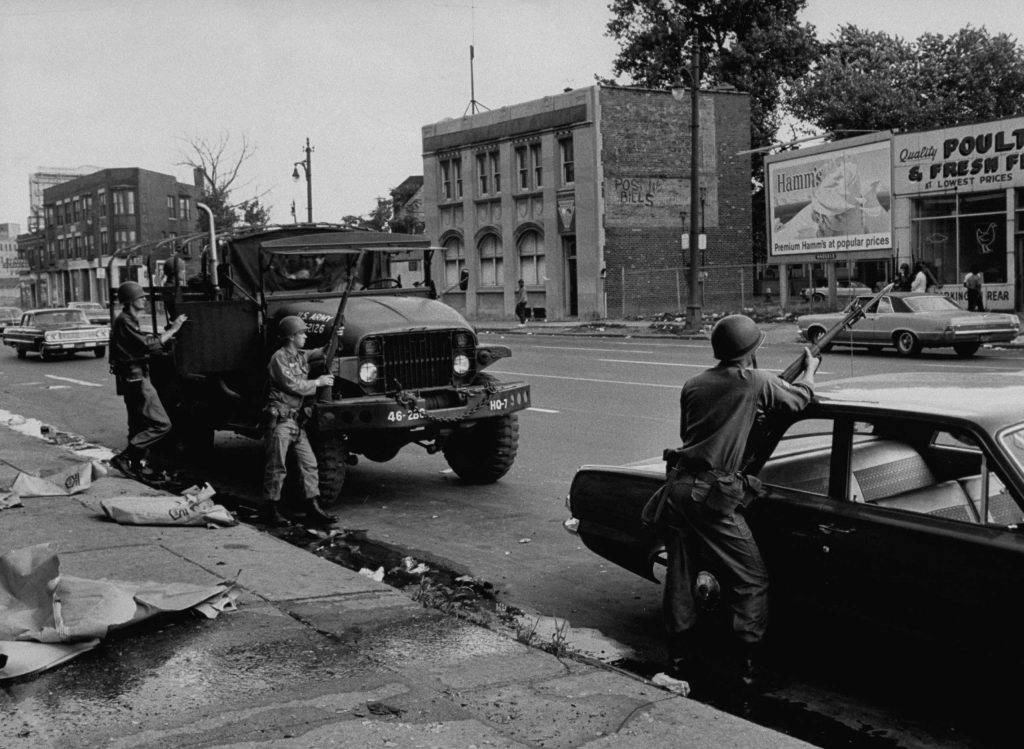Written By: Ben Cosgrove
Decades ago, during the long, hot summer of 1967, the city of Detroit erupted in one of the deadliest and costliest riots in the history of the United States. Reportedly sparked by a police raid on an unlicensed bar on July 23, the conflagration lasted four terrifying days and nights, left scores dead and hundreds injured, thousands arrested, untold numbers of businesses looted, hundreds of buildings utterly destroyed and Detroit’s reputation in tatters.
The reasons behind the riot, of course, are far thornier—socially, economically, racially —han a mere raid on a gin joint. While Detroit in the mid-Sixties had a larger black middle class than most American cities its size—thanks in large part to strong unions, high employment and the thriving, all-powerful auto industry—it was hardly a model of racial harmony. (During World War II, for example, Detroit was the scene of an infamous race riot caused in large part by tensions between whites and blacks over jobs in auto plants that were churning out tanks, planes and other war-related goods.)
But the 1967 eruption, also known as the 12th Street riot, was remarkable not only for how long it lasted, but for the force that the city, state and federal authorities brought to bear in an effort to impose order on a city in flames. Then-governor George Romney sent in thousands of National Guard troops, while President Lyndon Johnson eventually ordered paratroopers from the 82nd Airborne on to the streets.
Long before even a semblance of calm was restored, however, chaos reined, and horrific tales of assaults, beatings, robberies and killings poured out of the city including allegations, later reported on by the great journalist John Hersey, that Detroit police officers murdered three young black men at a Detroit motel in the midst of the riots.
Throughout it all, photographer Lee Balterman (who died in March 2012 at the age of 91) was there, recording the terrible scene. Here, LIFE.com presents a selection of his most powerful pictures, most of which were never published in LIFE, chronicling one of the bleakest chapters in American history four days that stunned a nation and left scars on a great city that are still seen and felt today.

Determined to protect their property, both African-American and white store owners brought out weapons and stood ready to use them.
Lee Balterman/Life Pictures/Shutterstock

Detroit, July 1967.
Lee Balterman/Life Pictures/Shutterstock

Detroit, July 1967.
Lee Balterman/Life Pictures/Shutterstock

Detroit, July 1967.
Lee Balterman/Life Pictures/Shutterstock

Detroit, July 1967.
Lee Balterman/Life Pictures/Shutterstock

Detroit, July 1967.
Lee Balterman/Life Pictures/Shutterstock

Police evacuated an apartment building in search of sniper suspects during the riots.
Lee Balterman/Life Pictures/Shutterstock

Detroit, July 1967.
Lee Balterman/Life Pictures/Shutterstock

A family took a walk in a neighborhood devastated by rioting.
Lee Balterman/Life Pictures/Shutterstock

The aftermath of the riots, Detroit, 1967.
Lee Balterman/Life Pictures/Shutterstock

The aftermath of the riots, Detroit, 1967.
Lee Balterman/Life Pictures/Shutterstock

A Detroit police officer stood guard over a grocery store looted during race riots.
Lee Balterman/Life Pictures/Shutterstock

Detroit, July 1967.
Lee Balterman/Life Pictures/Shutterstock

This family moved after the Detroit race riots.
Lee Balterman/Life Pictures/Shutterstock

A statue of Jesus Christ was smeared with brown paint during the riots.
Lee Balterman/Life Pictures/Shutterstock

The aftermath of the Detroit riots, July 1967.
Lee Balterman/Life Pictures/Shutterstock

The aftermath of the riots in Detroit, 1967.
Lee Balterman/Life Pictures/Shutterstock

The aftermath of the riots, Detroit, 1967.
Lee Balterman/Life Pictures/Shutterstock


























